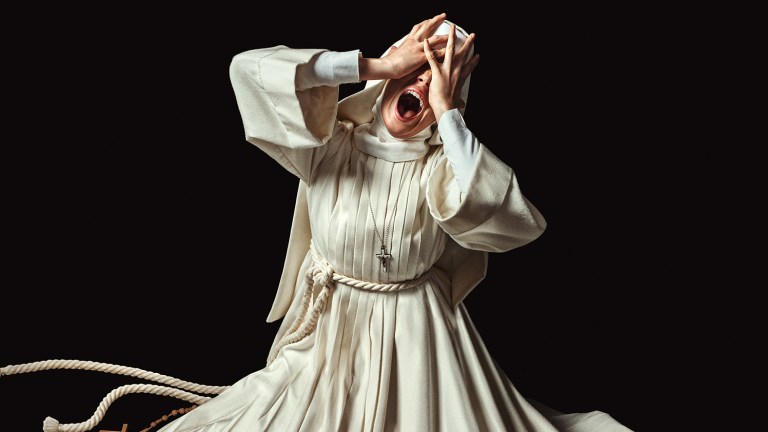Netflix’s Sister Death Is More Than Just a Retread of Veronica
Netflix's Sister Death is a prequel to Veronica, but it isn't another possession movie.

This article contains spoilers for Sister Death and Veronica.
You probably remember those hyperbolic headlines about 2017’s Veronica, the so-called scariest movie on Netflix, the horror film so frightening users turned it off midway through. Six years on, the internet has had plenty of time to reevaluate this Spanish-language chiller. Was it really that scary? This writer would say no, but art is subjective.
But even if it didn’t live up to all those internet headlines and tweets you read about it, director Paco Plaza’s possession film, which stars Sandra Escacena, is still a fun time, with a few genuinely unsettling moments throughout: the Ouija seance, the nightmare where Veronica’s siblings chomp down on her arms, the scene where Veronica chases the camera down a dark hallway, the demon itself. The movie, which is very loosely based on the unexplained death of a teen girl in 1991, is also dripping with style, down to the Spanish rock Veronica listens to with her friends, the posters that decorate her room, and the band t-shirts she wears. (And Plaza is right to include these nods to Heroes del Silencio, who still really slap all these years later.)
Now, the inevitable follow up to Veronica has dropped on the streaming service. Plaza returns to the director’s chair but with a new star in Aria Bedmar, who plays young novice Narcisa, the future nun Veronica and her high school friends will one day refer to as “Sister Death.” But Plaza, who is no stranger to horror sequels, having made two of them for the brilliant REC, which he also co-directed, hasn’t just made a paint-by-the-numbers retread. In fact, this month’s Sister Death is no possession movie at all.
Yes, you’re absolutely right in assuming this prequel is the origin story of how Sister Death lost her sight and began communing with the spirits and demons that will one day haunt high school girls, but Plaza has also given Narcisa more life than that. In fact, Narcisa’s backstory, which is told through the kind of grainy film footage you might find in a cult’s creepy basement, is quite interesting. We learn in the opening moments of the movie that, before Narcisa arrived at a convent to take her vows to God, she was a bit of a celebrity religious figure herself, the so-called “holy girl” of Spain whom people believed could commune directly with the Virgin Mary.
Whether Narcisa ever actually spoke to the Holy Mother is never really addressed in the movie, although she does soon begin to see things in the convent, such as chairs that flip over on their own, or the drawing of a hangman slowly being sketched on her bedroom wall. She has nightmares of eating fried eyeballs and being strangled by the veil she’ll soon wear when taking her vows. And Narcisa has much more to fear than God’s wrath when she enters the confessional: the many demonic eyeballs that watch her from the other side of the screen. These visions are tied to the convent’s own tragic past, which Narcisa eventually uncovers with the help of one of her students, a young girl who believes the convent is haunted by a vengeful spirit.
The prequel eventually ties Narcisa’s transformation into Sister Death to a solar eclipse in a nod to Veronica, who was herself possessed during one of these celestial events in the 2017 movie. An eclipse can be either a divine and demonic occurrence in this universe. The director uses the eclipse as the biblical serpent tempting the main characters — Narcisa stares directly into one despite the permanent damage that will entail, while Veronica plays with a Ouija board during one despite learning hours earlier that ancient groups used eclipses to summon dark spirits.
But beyond the theme of temptation that’s pretty par for the course for this type of movie, it’s the ambiguity of Narcisa’s own childhood that I keep coming back to as the more captivating way Sister Death communicates with Veronica. Like the real case of Estefanía Gutiérrez Lázaro that inspired the first film, the movie never provides a clear explanation for Narcisa’s early celebrity. What was really behind Lázaro’s hallucinations, seizures, hospitalization, and death months after performing a seance with a Ouija board? Are Narcisa’s “conversations” with Mother Mary actually egged on by a superstitious community desperate to believe? The movie spends too little time with that part of Narcisa’s story to even attempt an answer, and by the end, it’s defaulted back to the supernatural scares Veronica fans expect. We’ll never know the truth about the “holy girl,” like we’ll never know the truth about our real-life Veronica. That thread of mystery makes Sister Death a slightly more interesting prequel than just another horror cash-in. Either way, if Narcisa couldn’t speak to the spirits then, she definitely can now.
Sister Death is streaming now on Netflix.
